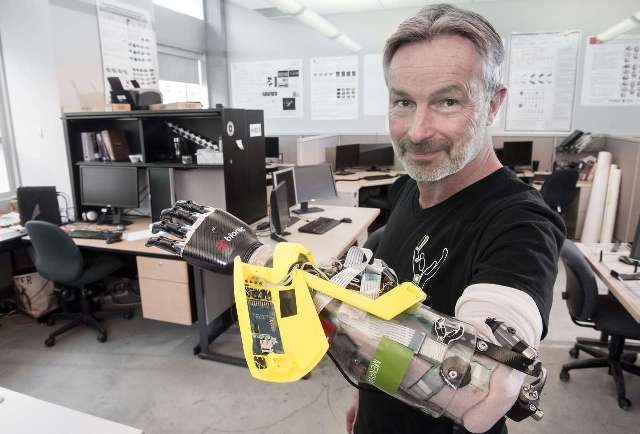May 4 2016
A Canadian athlete’s dream to one day “move” his fingers again after losing an arm in a workplace accident is now within grasp, thanks to a robotic arm prosthesis being developed at Simon Fraser University.
 Para-athlete Danny Letain can achieve greater control with his new "bionic hand" created by SFU researchers. Photo credit: Dale Northey
Para-athlete Danny Letain can achieve greater control with his new "bionic hand" created by SFU researchers. Photo credit: Dale Northey
SFU researchers are working with paralympic skier Danny Letain to design a new control system for one of the world’s most advanced bionic hands, promising a more intuitive experience for upper limb amputees.
Letain, a former locomotive engineer, lost his left arm below the elbow 35 years ago. He has since used a body-powered prosthesis with a pincer-like split hook that uses a series of straps to mechanically maneuver the artificial limb.
It’s a fatiguing process.
“The hook is durable and quick to respond, but controlling it with straps is not natural,” says Letain. Yet with the SFU team’s new control system, Letain already has a variety of different grip patterns that he says work “well beyond” what he could achieve with prosthetic devices.
Letain adds: “With this new system, it feels like I’m opening and closing my hand. The most exciting moment for me was feeling my left index finger and the little finger for the first time since my accident. With the hook you don’t use those muscles at all. This system puts my mind to work in a whole new way.”
SFU researchers build a better bionic hand
The technology was developed in engineering science professor Carlo Menon’s biomedical engineering lab initially to rehabilitate stroke patients. He immediately saw the potential for wider applications, however, including for amputees.
Menon says there is a high rejection rate among those with existing robotic prostheses because they are not intuitive.
“The problem is in the control systems, which have not significantly advanced in 50 years,” he says. “As a result, the robotic prostheses are not very useful for performing everyday tasks, and only about a quarter of amputees use them.”
The SFU team, known as M.A.S.S. Impact (Muscle Activity Sensor Strip), is applying its technology to a robotic arm on loan from Steeper Prosthetics, a company in Leeds, England. The SFU team has been working with Letain and staff at Vancouver’s Barber Prosthetics since June 2015.
The new system consists of an armband of pressure sensors embedded in the prosthetic socket. These track movements in Letain’s remaining muscles as he performs intuitive actions, such as grasping a bottle. Computer algorithms then map the sensor data to decode his intentions and move the prosthesis.
“The more data you give it, the more it will learn,” says SFU engineering science alumnus Lukas-Karim Merhi, who is leading the interdisciplinary team. The system also takes incoming data to make predictions in real time and generates computer models to improve future performance.
Brittany Pousett, head of research and development at Barber Prosthetics, says the system “is a completely new approach to picking up signal and controlling an electric prosthesis from someone’s body,” and could potentially increase the motion available to users.
These functions will be put to the test at the inaugural Cybathlon event in Zurich in October 2016. Dubbed the cyborg Olympics, the international competition is for people with disabilities who use robotic technology.
Organizers from the Swiss Federal Institute of Technology hope the event will spur innovations useful beyond the competition and allow people with disabilities to regain independence.
Letain will perform everyday tasks such as slicing bread and opening jars in an obstacle course for people with powered arm prostheses. The team tested the prototype at the Cybathlon trial held last July and is working to optimize the system for the competition.
The SFU team is the only Canadian team taking part alongside 80 teams from more than 30 countries. The researchers have launched a crowd-funding campaign to raise the funds needed to help send the team to Zurich to support Letain during the event. Donate to the campaign here.